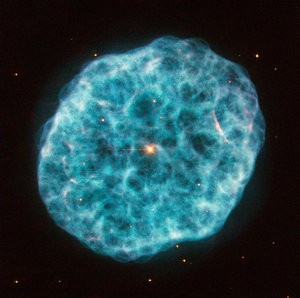

NGC 6210, planetary nebula
Shrouds of gas surrounding dying, sunlike stars (called planetary nebulae) come in a variety of strange shapes, from an 'hourglass' to a 'butterfly' or 'stingray'. With this image of NGC 6210, another bizarre form can be added to the gallery of planetary nebulae: a turtle swallowing a seashell. Giving this dying star a weird name is less challenging than working out how dying stars create these unusual shapes.The remarkable features of this nebula are the numerous holes in the inner shells with jets of material streaming from them. These jets produce column-shaped features that are mirrored in the opposite direction. The multiple shells of material ejected by the dying star give this planetary nebula its odd form. In the 'full nebula' image, the brighter central region looks like a 'nautilus shell'; the fainter outer structure (colored red) a 'tortoise'.The dying star is the white dot in the centre.





